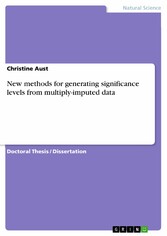Suchen und Finden
New methods for generating significance levels from multiply-imputed data
Doctoral Thesis / Dissertation from the year 2010 in the subject Mathematics - Statistics, grade: summa cum laude, University of Bamberg (Sozial- und Wirtschaftswissenschaften), language: English, abstract: Missing data are an ubiquitous problem in statistical analyses that has become an important research field in applied statistics. A highly useful technique to handle missing values in many settings is multiple imputation, that was first proposed by Rubin (1977, 1978) and extended in Rubin (1987). Due to the ongoing improvement in computer power in the last 10 years, multiple imputation has become a well known and often used tool in statistical analyses. However, there still exists a problem in generally obtaining significance levels from multiply-imputed data, because the application of multiple imputation requires normally distributed or t-distributed complete-data estimators. Today there are basically three methods that extend the suggestions given in Rubin (1987). First, Li, Raghunathan, and Rubin (1991) proposed a procedure, where significance levels are created by computing a modified Wald-test statistic that is then referred to an F-distribution. This procedure is essentially calibrated and the loss of power due to a finite number of imputations is quite modest in cases likely to occur in practice. But this procedure requires access to the completed-data estimates and their variance-covariance matrices, that may not be available in practice with standard software. Second, Meng and Rubin (1992) proposed a complete-data two-stage-likelihood-ratio-test-based procedure that in large samples is equivalent to the previous one. This procedure requires access to the code for the calculation of the log-likelihood-ratio statistics. Common statistical software does not provide access to the code in their standard analyses routines. Third, Li, Meng, Raghunathan, and Rubin (1991) developed an improved version of a method in Rubin (1987) that only requires the chi-square-statistics from a usual complete-data Wald-test. This method is only approximately calibrated and has a substantial loss of power compared to the previous two. To sum, there exist several procedures to generate significance levels in general from multiply-imputed data, but none of them has satisfactory applicability due to the facts mentioned above. Since many statistical analyses are based on hypothesis tests, especially on the Wald-test in regression analyses, it is very important to find a method that retains the advantages and overcomes the disadvantages of the existing procedures. Developing such a method was the aim of the present thesis.
Alle Preise verstehen sich inklusive der gesetzlichen MwSt.







